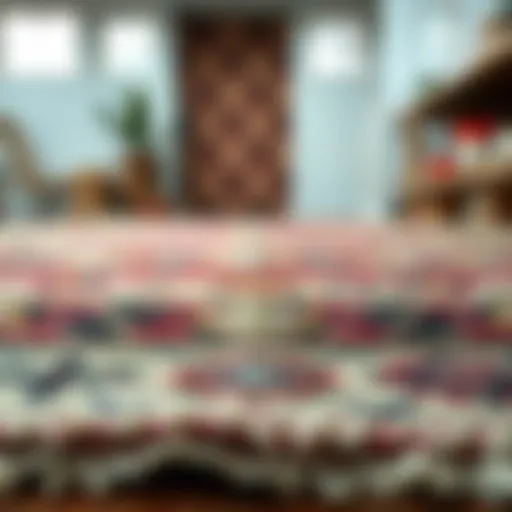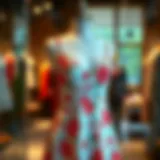The Luau Headband: Fashion and Cultural Insights
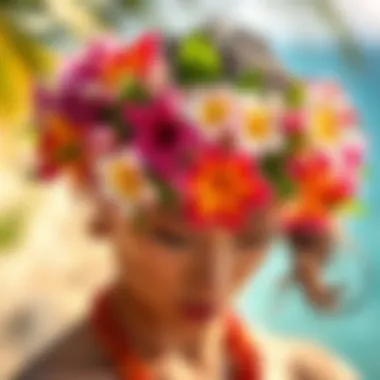

Intro
The luau headband, an accessory that often evokes visions of vibrant floral patterns and lively celebrations, is much more than a stylish ensemble addition. Its roots delve deep into Hawaiian culture, where it symbolizes a connection to heritage, community, and the natural world. When observing this piece, it’s crucial to grasp not only its aesthetic appeal but also the cultural narratives intertwined with each fabric choice and design.
As trends orbit through various fashion cycles, the luau headband has remained a notable component of both traditional and contemporary styles. This article aims to peel back the layers surrounding the luau headband, exploring the on-going significance it holds today.
Historical Context of the Luau Headband
The luau headband signifies more than just a fashionable accessory; it is steeped in a rich historical narrative that intertwines with Hawaiian culture. Understanding its historical context shows how the headband has evolved while maintaining connections to its roots. It reflects values of community, identity, and respect for tradition, crucial elements for anyone looking to comprehend the broader implications of Hawaiian cultural expressions. This intricate component of adornment tells stories that transcend time, influencing not only those who wear it but also the society around them.
Origins in Hawaiian Tradition
The origins of the luau headband can be traced back to ancient Hawaiian customs. Traditionally woven from natural materials such as ti leaves or grasses, these headbands were not just for decoration but also symbolized social status and belonging. In ceremonial contexts, the headband often showcased intricate designs that represented family lineage or specific deities.
From a young age, Hawaiians would learn the craft of making these accessories, passing down the knowledge through generations. The craft is about more than just making a headband; it embodies respect for nature and connects the wearer to their ancestors. It’s said that wearing a headband makes one feel closer to home, to the land themselves.
Cultural Representations in Art
Art in Hawaii has long been a reflection of the culture surrounding the luau headband. Iconic artists capture these unique elements in paintings and sculptures. Artists like Herb Kawainui Kane and others portray Hawaiian identity through vibrant, dynamic imagery that often showcases headbands in celebration scenes.
Moreover, the headband has inspired various forms of artistic expression, including contemporary dance and music, solidifying its status as a cultural symbol.
Many contemporary artists pay homage to these traditions by integrating typical designs and motifs of the luau headband into their works. This exploration helps to keep the concept of the headband alive and vibrant while helping newer generations appreciate and learn about their cultural heritage.
Cultural artifacts such as the luau headband carry stories that enrich the identity of the Hawaiian people, acting as a bridge between past and future, respect and celebration.
The fusion of historical references and modern interpretations showcases how the luau headband remains a symbol of pride and communal identity in Hawaiian culture, continuously telling a story of celebration, belonging, and respect.
Cultural Significance
The luau headband holds profound cultural significance, serving not only as a fashionable accessory but also as a symbol of identity and community. It embodies the spirit of Hawaiian culture and connects people across generations, traditions, and celebrations. The act of wearing a luau headband goes beyond mere aesthetics; it captures the essence of Hawaiian values, heritage, and the social fabric that holds communities together. Both tourists and locals frequently don the headband as a rite of passage during celebrations, bridging the gap between cultural appreciation and the vibrant history it represents.
Symbols of Community and Identity
The luau headband is a vivid representation of identity, embodying various cultural symbols that resonate deeply within Hawaiian society. At its core, the colors and patterns often used in these headbands reflect the natural beauty of Hawaii—bright greens, ocean blues, and earthy browns. These colors are not random; they signify landscapes and elements central to Hawaiian life, such as lush forests and clear waters.
- Connection to ancestry: Traditionally, many Hawaiian garments utilized in ceremonies had family significance, and the headband is no exception. Wearing it can signify one’s roots, honoring lineage and heritage. Families often pass down heirloom headbands, which absorb stories, emotions, and memories along the way.
- Inclusivity: During luaus or community gatherings, people from diverse backgrounds wear these headbands, symbolizing unity and diversity at the same time. It transforms occasions into vibrant displays of collective identity, showcasing how culture can be a shared experience rather than an exclusive one.
- Empowerment and pride: As a physical adornment, the headband is a source of empowerment, particularly for women. It reflects a pride in culture and self representation, acting as a reminder of their strength and role in society. Wearing this accessory connects individuals with their past and instills a sense of belonging.
"Cultural artifacts like the luau headband remind people of where they come from and instill pride in who they are."
The Luau as a Social Gathering
Celebrating traditions with a luau is an integral part of Hawaiian culture, and the luau headband enhances this communal experience. It is worn not just as an accessory, but as a conversation starter among attendees.
- An expression of festivity: Luaus often feature an array of cultural performances, food, and rituals. The headband, worn by participants, signifies joyous participation in these social rituals, enhancing the overall ambiance. It marks the joy of celebration, making it more than a mere party; it is a cultural homage.
- Facilitating connection: Guests wearing the headband become part of something larger than themselves—a tapestry of shared experiences, laughter, and stories. It fosters connections between individuals, both familiar and strangers, as they engage in the festivities. However, its significance does not just lie in aesthetic appeal; it becomes part of a larger narrative of community and camaraderie.
- Cultural Teaching: At luaus, the integration of the headband into broader festivities also acts as a learning opportunity for many. Tourists are often curious about the meaning behind the accessory, leading to educational discussions that promote cultural understanding and respect. It underscores the notion that every piece worn isn’t merely decoration; rather, it carries the weight of tradition.
The luau headband transcends its role as a fashionable piece by becoming a signifier of community and identity, an ever-relevant part of Hawaiian social gatherings.
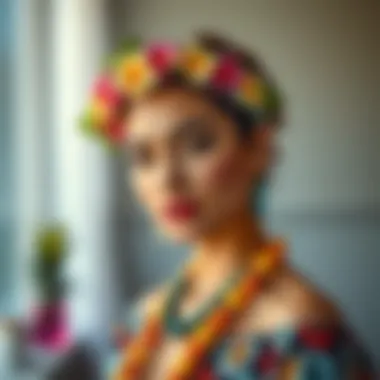

Designs and Variations
The designs and variations of the luau headband reflect a rich tapestry of cultural identity, artistic expression, and personal style. These imaginative patterns not only serve as decorative elements but also carry deep cultural significance and stories woven into their very fibers. Whether one opts for traditional designs or seeks modern twists, each choice opens a window into the values and aesthetics of Hawaiian heritage.
Traditional Patterns and Colors
Traditional luau headbands often showcase vibrant colors and intricate designs inspired by nature, mythology, and ancestral practices. Elements such as plumeria flowers, taro plants, and ocean waves are common motifs, rich in symbolism.
- Colors: Bright greens, blues, and earthy browns reflect the verdant beauty of the islands.
- Patterns: Geometric shapes and woven textures symbolize unity and the interconnectedness of the community.
- Materials: Historically, these headbands were crafted from materials like ti leaves or grasses, highlighting a connection to the land and sustainable practices.
Opting for these traditional patterns can invoke a sense of belonging and honor to the Hawaiian culture, making it more than just an accessory.
Modern Adaptations
Modern adaptations of the luau headband fuse traditional elements with contemporary fashion sensibilities, appealing to a broader audience while respecting the origins of the accessory.
Contemporary Trends in Fashion
In recent years, the popularity of the luau headband has surged, especially within the realms of festival fashion and summer wear. This surge can be attributed to several factors, including:
- Social Media Influence: Platforms such as Instagram and TikTok showcase influencers sporting these vibrant accessories, often pairing them with modern apparel.
- Fashion Sustainability: The demand for sustainable fashion has led to an increase in headbands made from eco-friendly materials, like organic cotton and recycled synthetics.
- Customization: Many designers now allow for personalization, where consumers can choose their fabric and design, making each headband a unique representation of identity.
These trends not only breathe new life into the classic headband but also encourage wearers to express their individuality while underpinning collective cultural themes.
Fusion with Other Styles
The fusion of the luau headband with other fashion styles has become a popular trend, especially among younger generations looking to redefine their identity through clothing.
- Mixing Cultures: By incorporating elements from different cultures, many designers create vibrant, eclectic styles that attract attention and spark conversations about cultural appreciation versus appropriation.
- Streetwear: The headband's adaptability means it can seamlessly fit into casual streetwear aesthetics, often styled with oversized apparel or layered accessories.
- Global Reach: As cultures intertwine, variations of the luau headband appear in various global fashion markets, thus promoting a sense of global unity.
However, this blending raises questions about cultural sensitivity. It's crucial for designers and consumers alike to balance creativity with respect for the origins of the designs they adopt.
The beauty of the luau headband lies not just in its aesthetic appeal but in its ability to connect wearers to their roots while jumping forward into modernity.
In summary, the designs and variations of the luau headband encapsulate a rich history and a modern reinterpretation, allowing it to serve both as a fashion statement and a cultural artifact. With each headband, an individual doesn’t just wear an accessory; they don a piece of history, identity, and community.
Material Choices
The choice of materials in crafting a luau headband stands as a crucial element that affects both its aesthetic appeal and cultural resonance. For a fashion accessory deeply rooted in tradition, the materials used can signify connection to the land and its resources, while also reflecting modern consumer expectations. When people wear a luau headband, they often appreciate not only its beautiful patterns but also the thoughtful decisions made behind its creation. This section examines the significance of material options and the implications they carry for sustainability, cultural preservation, and personal expression.
Natural Fibers Versus Synthetic
In the world of headband design, natural fibers and synthetic materials present different narratives. Natural fibers like cotton, bamboo, and hemp echo the essence of Hawaiian heritage. These materials resonate with the environment, offering a sense of authenticity. For instance, a headband made of pākī (bamboo) reflects a long-standing tradition and makes a statement about sustainability. Conversely, synthetic materials like polyester or nylon, while often cheaper and more durable, can create a disconnect from cultural roots.
- Natural Fibers:
- Synthetic Fibers:
- Promote sustainability and ecological sensitivity.
- Provide comfort and breathability, especially during tropical luaus.
- Can be intricate in design, often featuring vibrant, organic colors.
- Are generally easier to maintain and clean.
- Offer a broader array of colors and patterns at a lower cost.
- May lack the same cultural depth associated with natural materials.
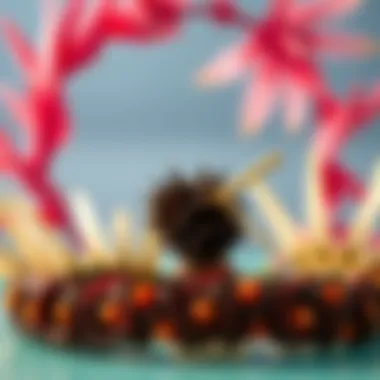
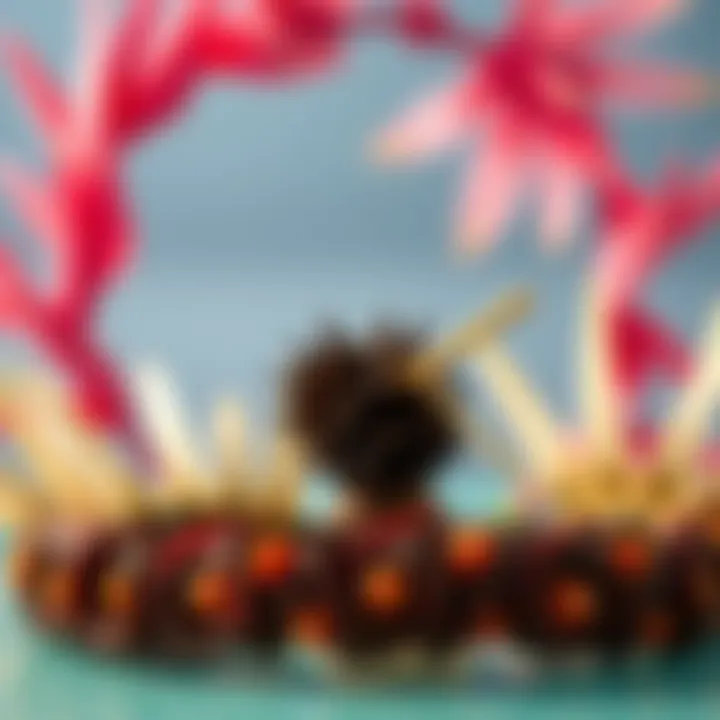
Ultimately, the choice between natural and synthetic fibers involves weighing personal values against practical needs. A fashion enthusiast may prefer the environmental advantages of natural fibers but also acknowledge the affordability of synthetics. The decision can often reflect one's identity and commitment to sustainable practices.
Sourcing and Sustainability Concerns
Ethical sourcing and sustainability increasingly influence material choices for headbands. As the world becomes aware of environmental impacts, creators and consumers alike are pondering the sources of their materials more critically. This contemplation extends to how those materials are extracted and processed.
One cannot overlook the impact of mass production in the fashion industry. While synthetic fibers can often be produced quickly, the environmental toll can be significant. Consider the chemicals released in the production process and the non-biodegradable nature of many synthetics. In contrast, natural fibers such as organic cotton, grown without harmful pesticides, provide an eco-friendlier option.
"In choosing local sources for materials, we can support community economies while minimizing the carbon footprint associated with transportation."
Additionally, incorporating sustainable practices into local crafts can enhance cultural preservation. Supporting small-scale artisans who utilize traditional techniques not only sustains cultural craftsmanship but also elevates the narrative of the luau headband. Using locally sourced materials helps maintain cultural integrity while promoting socio-economic growth within Hawaiian communities.
As we navigate the complex landscape of material choices, it's clear that informed decisions can foster environmentally responsible practices. Whether opting for natural fibers or embracing sustainable synthetics, each choice communicates a message—one of respect for the past and consideration for the future.
The Role of the Luau Headband in Modern Fashion
The luau headband, once primarily a symbol of tradition and cultural celebration in Hawaii, has evolved into a significant element in the contemporary fashion scene. This transformation indicates not merely a change in aesthetics but also a broader conversation about identity, cultural heritage, and community expression. In today’s world, the luau headband is more than just an accessory; it serves as a tangible link between past and present while embracing modernity. Its relevance in modern fashion encompasses several key aspects.
One of the primary elements to consider is how these headbands have found a home in social media. Platforms like Instagram and Pinterest are brimming with colorful photos showcasing diverse styles of luau headbands worn in various settings, from beach parties to music festivals. These images stir dialogues about authenticity, heritage, and individual expression. Moreover, social media influencers play a crucial role in setting trends—when they don a luau headband, it often becomes an instant fashion statement. Hence, it’s salient to see how the aesthetic choice of wearers can reflect their own narratives, intertwining personal identity with cultural representation.
"The true beauty of the luau headband lies not just in its design, but in the stories it carries with it, bridging cultures while celebrating individuality."
Several key benefits emerge from this modern resurgence. First, wearing a luau headband can serve as a conversation starter—be it about Hawaiian culture, sustainable fashion practices, or stylistic versatility. Furthermore, they are often crafted from eco-friendly materials, appealing to a growing demographic that prioritizes sustainability in their fashion choices. This aspect of the headband not only reinforces its cultural significance but promotes responsible consumerism in an era that often overlooks such considerations.
Influence of Social Media
The advent of social media has transformed how cultural artifacts like the luau headband are perceived and disseminated. Platforms such as TikTok and Instagram have provided a stage for fashion enthusiasts to showcase their creative interpretations of this traditional accessory. Users might post tutorials, style guides, or even stories linking their headbands to personal milestones, cultivating a sense of community around shared interests. This vast network allows for an incalculable array of representations, which may vary vastly from the traditional styles to more avant-garde interpretations, broadening exposure to Hawaiian culture far beyond its geographical boundaries.
Each post shared serves as a digital artifact, reflecting a person's viewpoint and experience. Therefore, it is essential to recognize how these platforms contribute to a modern renaissance of appreciation for cultural pieces like the luau headband. Such visibility not only elevates the item’s status in the fashion world but also generates global interest in Hawaiian culture.
Fashion Shows and Industry Trends
The luau headband’s presence in fashion shows marks another layer of its integration into modern fashion. Designers from various backgrounds are increasingly incorporating these headbands into their collections, showcasing the ability to blend traditional elements with contemporary styles. During fashion weeks, these headbands can often be seen as part of beachwear collections or resort wear—perfectly aligned with seasonal releases and lifestyle trends.
Designers such as Naeem Khan and Anna Sui have been known to incorporate cultural elements into their lines, highlighting the impact of cross-cultural influences in high fashion. The inclusion of luau headbands often reflects a message of unity, illustrating how fashion can traverse boundaries, blending various traditions through innovative design choices.
While attending fashion shows, observers frequently note how these headbands can complement both female and male models, illustrating their versatility. This appeal helps to solidify the luau headband’s place in the marketplace toward emerging trends, making it a sought-after accessory not just in Hawaii but around the world.
DIY Luau Headband Creations
Creating your own luau headband not only adds a personal touch to this traditional accessory but also embodies the spirit of creativity and self-expression. As this article has explored the cultural context and significance behind the headband, the DIY approach emphasizes the importance of these elements in crafting. This section provides insight into benefits of making your own headband and practical considerations to keep in mind while doing so.
Guides to Crafting Your Own
When it comes to crafting a luau headband, the process can be both fun and fulfilling. Here are some steps and tips to get you started:
- Select Your Materials: Start with natural fibers or fabric that resonate with the colors of Hawaiian culture, such as vibrant greens, yellows, and blues, reflecting the lush landscape. Floral patterns or local motifs can make the headband truly stand out.
- Choose a Base: A flexible band, like a piece of ribbon or braided grass, can serve as an excellent base. This gives room to attach various decorative elements.
- Add Decorations: Here’s where you can let your imagination run wild. Use artificial flowers, beads, or even shells. Each clip can tell a story or represent a personal connection to Hawaiian culture or landscapes.
- Secure Everything: Ensure that attachments are secure, using a hot glue gun or sturdy thread if needed. A headband should be comfortable and stable while worn.
- Incorporate Personal Touches: Personalize it further by including initials or symbols that resonate with your experiences. This will elevate the headband beyond mere decoration.

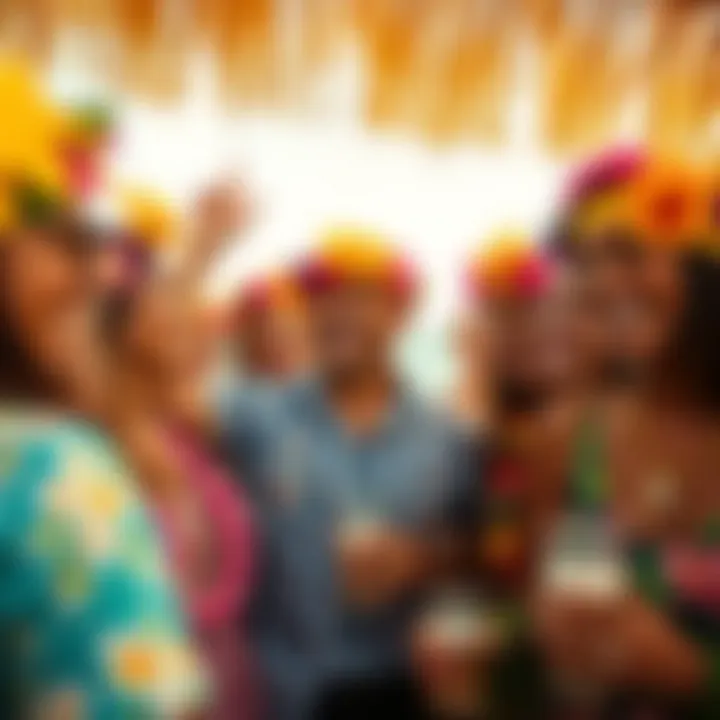
Following these steps, you can create a unique accessory that carries both beauty and meaning. Not only does it serve as a fashion statement, but it also reinforces the bond between the maker and the cultural heritage of the luau.
Incorporating Sustainable Practices
In this time of growing environmental consciousness, applying sustainable practices in crafting your luau headband is not only thoughtful but essential. Here are some considerations:
- Material Sourcing: Choose local materials wherever possible. Not only does this support local economies, but it also minimizes carbon footprint by reducing transportation distances.
- Reusing and Recycling: Look for materials you may already have at home. Old fabric, scraps from other projects, or even unused accessories can find new life in your headband design.
- Biodegradable Adhesives: If you choose to use adhesives, opt for those that are eco-friendly. This helps in ensuring that your creation leaves a minimal impact on the environment after its life cycle.
- Educate and Share: Encourage others in your community to adopt sustainable practices when creating their own accessories. Sharing knowledge can lead to a larger movement toward responsible crafting.
By creating your own luau headband with sustainable practices, you aren't just adding to your wardrobe. You are making a statement about your values and respecting the culture from which this beautiful accessory originates.
Impact of Globalization
Globalization has a profound influence on a variety of cultural artifacts, and the luau headband is no exception. As the world becomes increasingly interconnected, the exchange of ideas, styles, and traditions creates complexities in how we view cultural items like the luau headband. Its journey from a traditional Hawaiian accessory to a globally recognized fashion item offers valuable insights into contemporary fashion dynamics.
The evolution of the luau headband highlights both benefits and considerations that come with the tide of globalization. On one hand, it enables a wider appreciation for Hawaiian culture, allowing people from different backgrounds to engage with and celebrate its beauty. This cross-cultural exposure can create a vibrant dialogue around fashion, fostering a sense of unity and shared identity among diverse populations.
However, the flipside to this phenomenon is the concern over cultural appropriation. The line between appreciation and appropriation is notoriously thin. When individuals or brands borrow cultural symbols without understanding their significance, it can lead to distorted representations that discredit their origins. This situation raises questions about who gets to wear such cultural signifiers and under what context. The respectful engagement with the luau headband entails acknowledging its roots and significance rather than simply viewing it as a trendy accessory.
The success of the luau headband in global fashion circles serves as a reminder of the fine balance between sharing culture and preserving its integrity. Through mindful practices, we can honor this accessory's cultural significance while simultaneously enjoying its aesthetic appeal.
Cultural Appropriation Versus Appreciation
The conversation surrounding cultural appropriation versus appreciation is nuanced and layered, particularly when we consider items like the luau headband. Cultural appropriation describes the act of taking or using elements of one culture by another, often without permission or proper understanding. This can trivialize the original culture and commoditize its traditions, leading to feelings of disrespect among members of that culture.
For instance, when fashion brands produce luau headbands featuring traditional motifs without engaging with Hawaiian artisans or understanding the symbolism behind the designs, it raises red flags. This can erase the community's history, relegating its significance to mere aesthetics.
On the other hand, cultural appreciation involves a genuine reverence for the original culture. This means understanding the stories behind the luau headband's motifs and paying homage to its significance within Hawaiian tradition. Collaborations with local artisans can transform a mere fashion statement into a celebration of culture, ensuring that those who wear it respect its origins.
A successful example of this is seen when designers partner with Hawaiian artists to create limited editions of headbands, thereby enriching their products with authentic narratives. These collaborations can educate consumers while simultaneously empowering local communities.
Market Trends in Cross-Cultural Fashion
The luau headband is just one piece in the ever-evolving puzzle of cross-cultural fashion. Market trends indicate a growing demand for items that reflect diverse cultures, but it is essential to scrutinize how these items are marketed and perceived. Brands capitalizing on this trend often do so with a focus on aesthetic appeal, but more conscientious brands are recognizing the added value of storytelling.
For example, social media has become a powerful platform for brands to share authentic narratives behind their products. Many consumers today prioritize transparency and ethically made goods. Once seen simply as an accessory, the luau headband now tells a story of celebration and affiliation, resonating well with audiences seeking meaningful connections to the pieces they wear.
Moreover, this intertwining of cultures can drive innovation in design. We see hybrid styles gaining traction, merging the classic Hawaiian elements with contemporary fashion motifs. This trend not only broadens market appeal but also encourages a deeper understanding of cultural roots among consumers.
As fashion enthusiasts, designers, and consumers navigate these waters, the need for critical engagement with cultural artifacts like the luau headband remains vital. With globalization enhancing both accessibility and exposure, it becomes everyone's responsibility to appreciate while respecting the cultural significance woven into these beautiful pieces.
For further exploration of cultural trends in fashion, visit Wikipedia.
Epilogue
The conclusion serves as the culmination of the myriad of ideas presented in this article about the luau headband, highlighting its significant role not only as a fashion accessory but also as a potent symbol of cultural identity. When diving into the reflections on identity and expression, it becomes clear that the luau headband embodies more than just aesthetics; it encapsulates the spirit of Hawaii and the essence of community. Each wear signifies a connection to heritage and a celebration of life’s milestones, whether at a traditional luau or a contemporary gathering.
Reflections on Identity and Expression
As we reflect on the luau headband, it’s essential to grasp how it acts as a canvas for personal and cultural expression. Adorning oneself with this headband is more than a stylistic choice; it’s a reflection of one’s roots and an homage to the Hawaiian culture. Each pattern and color carries profound meanings, inviting wearers to tell their stories and affirm their identities. In modern times, the luau headband connects generations, serving as a bridge where the past meets the present and where individuals can showcase their unique identity rooted in collective tradition. The headband, therefore, highlights individuality in diversity, demonstrating that fashion can be a vessel for expressing one's unique narrative.
Future of the Luau Headband in Fashion
Looking ahead, the luau headband is poised to continue evolving within the ever-changing landscape of fashion. As global interest in sustainable and ethically sourced products increases, the emphasis on traditional craftsmanship offers a promising avenue for the headband's future. Fashion designers are likely to incorporate Hawaiian motifs into mainstream styles, embracing not just the aesthetic value but also the underlying stories woven into the fabric. This cross-pollination between traditional and contemporary practices presents an opportunity to challenge perceptions and encourage a deeper appreciation for cultural symbols.
Moreover, social media platforms amplify these opportunities, allowing the stories and visuals tied to the luau headband to reach broader audiences. The blend of traditional craftsmanship with modern-day trends can enhance visibility and foster greater respect for its origins. Hence, while the luau headband continues to serve as a vibrant piece of art, it also remains a staple in discussions about identity, fashion, and environmental sustainability.



